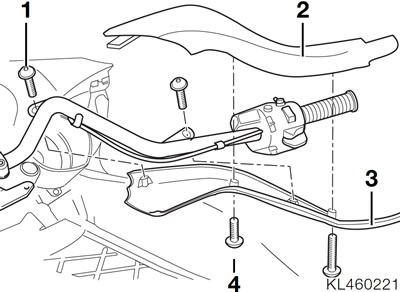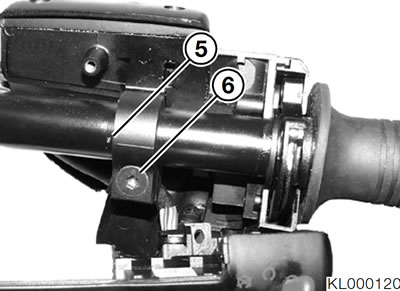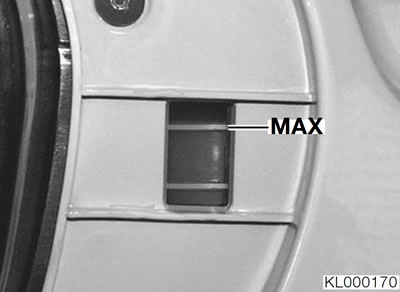Caution: Do not allow brake fluid to come into contact with painted parts of the motorcycle, because brake fluid destroys paint.
Front brake
- Place the motorcycle on its centre stand so that it is level.

- Release the fastener (4) and remove the top handlebar trim (2).
- Release the fastener (1) and remove the bottom handlebar trim (3).
- Unscrew the combination switch.
- Turn the handlebars to full left lock.

Note: The punch mark (5) on the handlebar indicates the installed position.
- Loosen the clamping screw (6).
- Rotate the brake fluid reservoir so that the sealing surface on the reservoir cap is horizontal when viewed from the side.
- Tighten the clamping screw (6).
- Remove the reservoir cap together with the diaphragm.

- Check brake fluid level.
- Top up the fluid level and, if necessary, check the brake system for leaks if the brake fluid level is below the "MAX" mark with new brake pads.
Required level:
- Installation is the reverse of the removal procedure: pay particular attention to the following.
Note: Wipe the rim of the reservoir, the rubber gaiter and the cover to remove brake fluid, and carefully reassemble the components.
- Hand-tighten the screws securing the reservoir cap.
- Return the brake fluid reservoir to the marked position.
Note: Take care with the routing of the wires and cables when fitting the handlebar trim.
Tightening torque:
- Clamping screw — 5 Nm
- Trim panels — 2 Nm
Rear brake
- Place motorcycle on its centre stand.
- Open the right-hand side case.

Caution: The fluid level in the brake fluid reservoir must be at the "MAX" mark with new brake pads.
Read off the level of brake fluid in the reservoir on the inspection glass at the front of the case. You may need to use a torch to light up the reservoir from behind.
Required level: MAX
